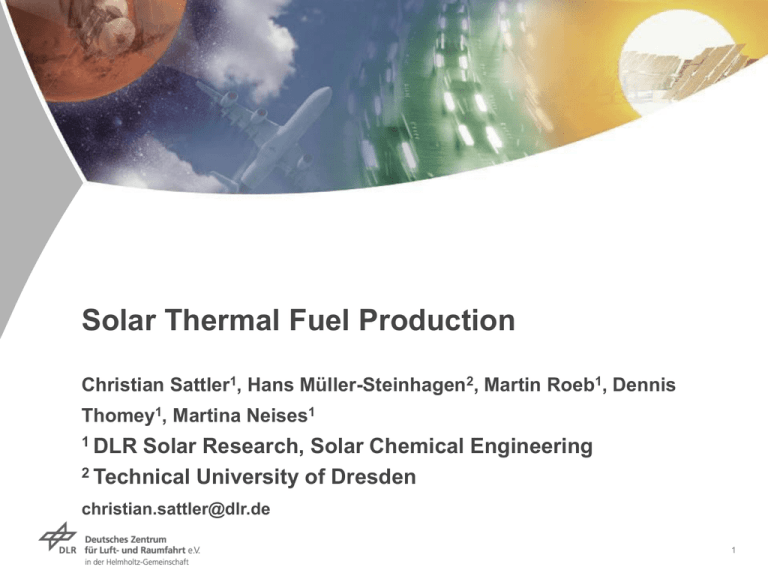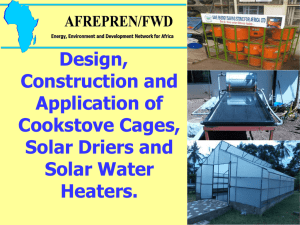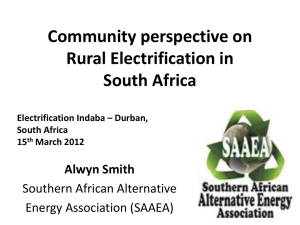Solar Towers - eLib
advertisement

Solar Thermal Fuel Production Christian Sattler1, Hans Müller-Steinhagen2, Martin Roeb1, Dennis Thomey1, Martina Neises1 1 DLR Solar Research, Solar Chemical Engineering 2 Technical University of Dresden christian.sattler@dlr.de 1 Overview Reasons for solar thermal fuel production Two examples SET-Plan Powertrains for Europe Concentrating Solar Systems Solar Fuels short and long term applications Processes Projects and existing pilot plants Summary and Outlook 2 Political view: SET-Plan (2007) European Strategic Plan for Energy Technology Development of energy technologies plays a crucial role for climate protection and the security of the global and European energy supply Goals of the EU until 2020 (20/20/20) 20% higher energy efficiency, 20% less GHG emission,, 20% renewable energy Actions in the field of energy efficiency, codes and standards, funding mechanisms, and the charging of carbon emissions necessary Significant research effort is necessary for the development of a new generation of CO2 emission free energy technologies, like Offshore-Wind, Solar 2nd generation Biomass Goal of the EU until 2050: 80% less CO2 emissions than in 1990 3 Production-, Storage- and Infrastructure topics of the European Hydrogen and Fuel Cell JTI 4 Example for industrial view: „Powertrains for Europe“ 2010 fact based analysis on a portfolio of power-trains by McKinsey & Company for: Car manufacturers: BMW AG, Daimler AG, Ford, General Motors LLC, Honda R&D, Hyundai Motor Company, Kia Motors Corporation, Nissan, Renault, Toyota Motor Corporation, Volkswagen Oil and gas: ENI Refining and Marketing, Galp Energia, OMV Refining and Marketing GmbH, Shell Downstream Services International B.V., Total Raffinage Marketing Utilities: EnBW Baden-Wuerttemberg AG, Vattenfall Industrial gas companies: Air Liquide, Air Products, The Linde Group Equipment car manufacturers: Intelligent Energy Holdings plc, Powertech Wind: Nordex Electrolyser companies: ELT Elektrolyse Technik, Hydrogenics, Hydrogen Technologies, Proton Energy Systems NGO: European Climate Foundation GOs: European Fuel Cells and Hydrogen Joint Undertaking, NOW GmbH Available online at: http://ec.europa.eu/research/fch/index_en.cfm 5 Development of EU GHG emissions [Gt CO2e] 6 Three Power Trains FCEV, BEV, and PHEV were evaluated against ICEs in three scenarios, on three types of cars, small, medium and large covering 75% of the European Fleet 7 Results 8 Total EU car fleet, million vehicles 9 Hydrogen production – benchmark processes for solar technologies 10 Concentrating Solar Technologies 11 Energy Routes Solar Energy Heat Solar-thermal Radiation Fossil Resources Biomass CO2 PV Heat Synthetic Fuels Mechanical Energy Power Thermochemistry Electrolysis Photochemistry Hydrogen 12 Temperature Levels of CSP Technologies 3500 °C Paraboloid: „Dish“ 1500 °C 400 °C Solar Tower (Central Receiver System) 150 °C 50 °C Parabolic Trough / Linear Fresnel 13 Annual Efficiency of Solar Power Towers Optical efficiency and thermal annual use efficiency [%] Power Tower 100MWth Optical and thermal efficiency / Receiver-Temperature 50 45 40 35 30 25 20 15 10 5 0 600 700 800 900 1000 1100 Receiver-Temperature [°C] 1200 1300 1400 R.Buck, A. Pfahl, DLR, 2007 14 Solar Towers, “Central Receiver Systems” PS10+20, Sevilla, E PSA CESA-1, Almería, E Solar-Two, Daggett, USA Solarturm Jülich, D 15 Principle of the solar thermal fuel production Recourses Natural Gas Water, CO2 Chemical Reactor Heat Solar Tower Fuel H2 CO + H2 Industry Transportation Energy Converter Fuel Cell Transportation Power Production 16 CO2 Reduction by solar heating of state of the art processes like steam methane reforming and coal gasification 30 CG 25 kg/kg 20 CO2 Reduction 20 – 50% 15 SPCR SMR 10 SSMR 5 0 SMR SSMR CG SPCR 17 Efficiency comparison for solar hydrogen production from water (SANDIA, 2008)* Process T [°C] Solar plant Solarreceiver + power [MWth] η T/C (HHV) η Optical η Receiver η Annual Efficiency Solar – H2 Elctrolysis (+solarthermal power) NA Actual Solar tower Molten Salt 700 30% 57% 83% 14% High temperature steam electrolysis 850 Future Solar tower Particle 700 45% 57% 76,2% 20% Hybrid Sulfurprocess 850 Future Solar tower Particle 700 51% 57% 76% 22% Hybrid Copper Chlorine-process 600 Future Solar tower Molten Salt 700 49% 57% 83% 23% Nickel Manganese Ferrit Process 1800 Future Solar dish Rotating Disc <1 52% 77% 62% 25% *G.J. Kolb, R.B. Diver SAND 2008-1900 18 Short-term CO2-Reduction: Solar Reforming 19 Steam and CO2-Reforming of Natural Gas Steam reforming: H2O + CH4 3 H2 + 1 CO CO2 Reforming: CO2 + CH4 2 H2 + 2 CO Reforming of mixtures of CO2/H2O is possible and common Use of CO2 for methanol production: e.g. 2H2 + CO CH3COH (Methanol) Both technologies can be driven by solar energy as shown in the projects: CAESAR, ASTERIX, SOLASYS, SOLREF… 20 Solar Methane Reforming – Technologies decoupled/allothermal indirect (tube reactor) Integrated, direct, volumetric Source: DLR Reformer heated externally (700 to 850°C) Optional heat storage (up to 24/7) E.g. ASTERIX project Irradiated reformer tubes (up to 850°C), temperature gradient Approx. 70 % Reformer-h Catalytic active direct irradiated absorber Approx. 90 % Reformer-h Development: CSIRO, Australia and in Japan; Research in Germany and Israel Australian solar gas plant in preparation High solar flux, works only by direct solar radiation DLR coordinated projects: Solasys, Solref; Research in Israel, Japan 21 Project Asterix: Allothermal Steam Reforming of Methan DLR, Steinmüller, CIEMAT 180 kW plant at the Plataforma Solar de Almería, Spain (1990) Convective heated tube cracker as reformer Tubular receiver for air heating 22 “Indirect heated“ tube receiver: CSIRO Solargas Indirect reactor technology Second tower at the CSIRO Solar Centre Newcastle, NSW, Australia Test facility for different Reactors One will be the volumetric SOLREF reactor Coordination by CSIRO, DLR is partner in an IPHE project 23 Direct heated volumetric receivers: SOLASYS, SOLREF (EU FP4, FP6) Pressurised solar receiver, Developed by DLR Tested at the Weizmann Institute of Science, Israel Power coupled into the process gas: 220 kWth and 400 kWth Reforming temperature: between 765°C and 1000°C Pressure: SOLASYS 9 bar, SOLREF 15 bar Methane Conversion: max. 78 % (= theor. balance) DLR (D), WIS (IL), ETH (CH), Johnson Matthey (UK), APTL (GR), HYGEAR (NL), SHAP (I) 24 Pilot plant for solar pet-coke reformig - SYNPET 500 kW SYNPET solar reactor Plataforma Solar de Almería Production: 100-180 kg/h Synthesis gas CIEMAT (E), ETH (CH), PDVESA (VEN) T Denk et al., CIEMAT, 2009 25 Example: Possible sites in Algeria Pipelines Fields kWh/m²/y 50 km distance to pipelines Acceptable DNI Available Land 26 Analysis of relevant Technologies for H2 Production (until 2020) Grid Electricity electrolysis Wind electrolysis Biomass 12* €/GJ 31 €/GJ 50-67 €/GJ 25-33 €/GJ modest modest high high high high neutral modest modest - high NG SMR NG SolarSMR H2 production cost 8* €/GJ Positive impact on security of energy supply Positive impact on GHG emission reduction negative -neutral high high *assuming a NG price of 4€/GJ; NG Solar-SMR: expected costs for large scale, solar-only 27 Long-term: Water splitting processes 28 Promising and well researched Thermochemical Cycles Steps Maximum Temperature (°C) LHV Efficiency (%) Hybrid Sulphur (Westinghouse, ISPRA Mark 11) 2 900 (1150 without catalyst) 43 Sulphur Iodine (General Atomics, ISPRA Mark 16) 3 900 (1150 without catalyst) 38 2 1800 45 1600 42 Sulphur Cycles Volatile Metal Oxide Cycles Zinc/Zinc Oxide Hybrid Cadmium Non-volatile Metal Oxide Cycles Iron Oxide 2 2200 42 Cerium Oxide 2 2000 68 Ferrites 2 1100 – 1800 43 4 530 39 Low-Temperature Cycles Hybrid Copper Chlorine 29 Process scheme of a metal oxide TCC* 1. Step: Water splitting H2O + MOred MOox + H2 H2O MO MO H2 red O ox 800 – 1200 °C 2. Splitting: Regeneration MOox MOred + ½ O2 Net reaction: H2O H2 + ½ O2 O2red MO MO ox 1200° C *Roeb, Müller-Steinhagen, Science-Mag., Aug. 2010. 30 Pilotplant for solar water splitting by ferrites HYDROSOL 2 100 kW HYDROSOL 2 (EU FP6) Solarreaktor, Plataforma Solar de Almería, Spanien APTL (GR), CIEMAT (E), DLR (D), Johnsson Matthey (UK), STC (DK) Concentration of hydrogen detected by GC M. Roeb et al., DLR, 2009 31 Scale-up: 100kW-pilot-plant 32 Modelling of the pilot plant - Overview Modelling: Parameter Insulated Power (#1) Modelling-Control Software (Labview®) Parameter Temperature (#2) Parameter HeliostatfieldSimulation Tool STRAL (C++) Temperature Model (Matlab/Simulink®) Hydrogen Production Model Hydrogen Amount (#3) 33 Q HS Modelling – Temperature model: Collecting formulas of the heat flows (simplified balance!) Q GaBa Q KGa Q Q aK GB Q KK Q KF Q aK Q KF Q HS Q aF Q aF Heat flows: heat radiation, heat conduction and convection 34 Modelling – Temperature model: First Verification of open loop control system Regeneration Temperatures East (23.04.2009) Input: 1400 Simulated power East 1200 Sampling rate (Sim.): 1000 every second T [°C] 800 Sampling rate (Exp.): 600 Every second 400 Average Deviation: 6.5% 200 Temperature Simulated Temperature Measured :0 0 :0 0 :0 0 15 :4 5 :0 0 14 :3 0 :0 0 14 :1 5 :0 0 14 :0 0 :0 0 14 :0 0 :4 5 13 :3 0 :0 0 13 :1 5 :0 0 Time 13 :0 0 :0 0 13 :4 5 :0 0 12 :3 0 :0 0 12 :1 5 :0 0 12 :0 0 :0 0 12 :4 5 :0 0 11 :3 0 :0 0 11 :1 5 :0 0 11 :0 0 :0 0 11 :4 5 :0 0 10 :3 0 10 10 :1 5 :0 0 0 Production 35 Conclusion and Outlook 36 Future Solar Thermal Plants Production of solar fuels (renewable H2 and CH4 / CH3OH), Recycling of CO2, Power production and Desalination (H2O) H2 H 2O CO2 Power CH4, CH3OH Heat Desalinated Water Sea water 37 Conclusion and Outlook CO2 lean/free hydrogen is crucial for the energy economy no matter how the development will be To achieve the energy/emission goals for 2020 promising renewable technologies like solar thermal must be implemented now, at the right places Things to be done: Secure and enhance the know-how by strong co-operations of industry and R&D Close technological gaps Transfer of the technology to industry Provide technology for growing markets in solar regions 38 Acknowledgment The Projects HYDROSOL, HYDROSOL II; HYTHEC, HYCYCLES, Hi2H2, INNOHYP-CA, SOLHYCARB and SOLREF were co-financed by the European Commission HYDROSOL 3-D and ADEL are co-financed by the European Joint Technology Initiative on Hydrogen and Fuel Cells HYDROSOL was awarded Eco Tech Award Expo 2005, Tokyo IPHE Technical Achievement Award 2006 Descartes Research Price 2006 39 Mahalo for your attention! 40








